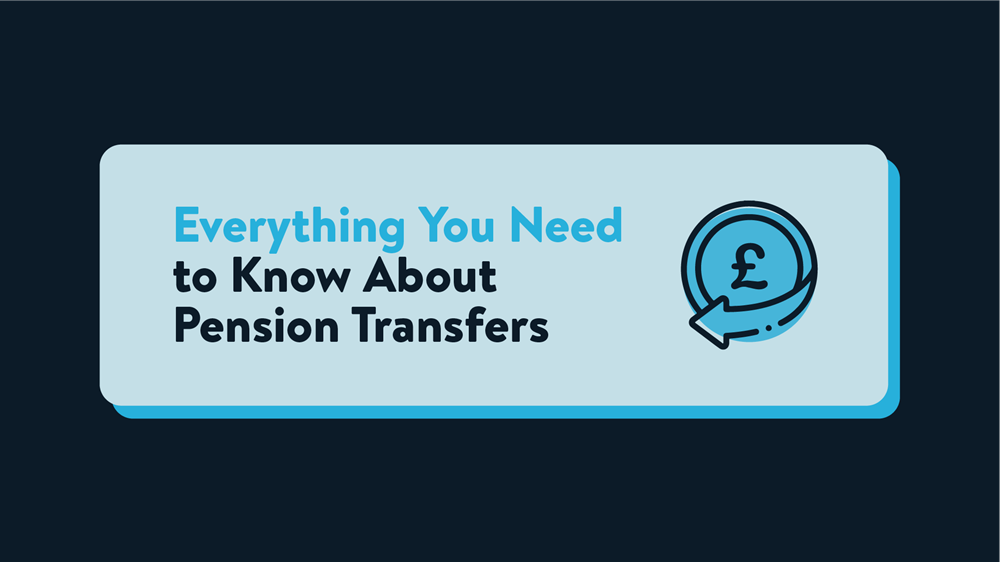When it comes to setting yourself up for retirement as best as you can, one of the questions we often hear is: “Should I transfer my pension?”
As with many financial decisions (especially pension-related ones), the answer is complex — with no one-size-fits-all solution.
However, if you don’t feel your pension is working hard enough – or have multiple ones with different providers from past jobs – then it could be worth transferring.
So, to help you consider whether or not transferring pensions might be right for you, we’ve put together this handy guide.
If, by the end of this piece, you’re still unsure, you should speak to a regulated financial adviser. Alternatively, the government-backed website, MoneyHelper, offers plenty of free and impartial pension-related information.
Why should I transfer my pension?
There are many reasons for transferring pensions to a new provider, including:
Easier to manage
Imagine, for example, having eight bank accounts — each one with a different debit card and amount of money. Keeping track of and managing them all separately might become a bit of a faff, right?
Well, the same theory applies to your pensions.
After all, if you’ve moved jobs several times throughout your career, chances are you’ve also got several different workplace pensions. As a result, knowing how much you have tucked away for retirement might feel complicated and stressful.
If you’re looking for an easier-to-manage option, then transferring and consolidating all your pensions into one Personal Pension provides a single pot of money, set of fees, and withdrawal policy.
Reduced fees
On the subject of fees, transferring pensions could potentially help you save money if you’re paying more elsewhere. Before moving your pot(s) to a single provider, however, always check to see if you’ll need to pay any transfer or exit fees first.
Better performance and service
Being disappointed with the performance or service you’re getting from your current providers could be another reason for transferring pensions. Even though things like investment strategy and customer service could impact the financial future of your pension, it’s important to do your research before making a final decision.

What are the considerations for transferring a pension?
As well as understanding provider fees and potential exit charges, there are a few other things to consider if you’re still wondering “should I transfer my pension?”
- Combining two or more pensions doesn’t guarantee more money in retirement, and investment performance is never guaranteed.
- If your pension is worth £30,000 or more and has safeguarded benefits (such as a defined benefit scheme), you’ll need to get financial advice before doing anything.
- While the transfer takes place, your pension will be ‘out of the market’, as your existing provider needs to sell your investments before transferring it as cash.
Some providers will be able to transfer your money whilst it’s still invested. Known as an 'in-specie' transfer, this may incur additional charges.
Certain providers can't accept transfers of pensions:
- You’re already taking an income from.
- With safeguarded benefits, such as defined benefit pensions.
- With a guaranteed income.
- Where you can get more than your 25% tax-free cash.
If you do transfer a defined benefit pension to another provider, you may lose some of the valuable benefits attached to it.
Not all providers accept the transfer of a defined benefit pension, so make sure you check this before requesting a transfer.
Partial transfers
As the name suggests, a partial transfer lets you move part of a pension to another scheme.
However, you’ll need to see whether your provider will allow a partial transfer and, if so, be aware that you might lose (or experience a reduction in) your:
- Lifetime allowance protection.
- Lump sum protection specific to the scheme.
- Pension age protection.
Can I transfer a crystallised pension?
A crystallised pension simply refers to a pension you’ve started taking benefits from.
Ill health aside, the earliest a pension can become crystallised is aged 55 (rising to 57 in April 2028). Being able to transfer one depends on two factors: the type of pension you have, and the provider (although crystallised pensions can’t usually be partially transferred).
Defined benefit pension: A crystallised defined benefit pension can’t be transferred. Any transfers need to be made up to a year before you start getting payments from it.
Defined contribution pension: This type of pension can be transferred to another provider, but all crystallised funds must be transferred at the same time.
Annuity: As long as you’ve confirmed with your providers that they’re able to do so, you can transfer a crystallised annuity, yes.
Can you transfer your pension to someone else?
If you’ve ever wondered “how do I transfer a pension to my family or friends?”, the short answer is that you can’t — while you’re alive, at least!
You can, however, nominate these people to become beneficiaries of your pension(s), which means they could be entitled to any death benefits once you’ve passed away.
Can I combine old pensions?

Yes — what’s more, you can do it with Wealthify.
And, as we’ve already mentioned, transferring pensions to one provider could make managing your retirement pot easier and cheaper. All it takes is four simple steps — you can visit our pension consolidation page to find out more and get started.
How do I trace an old pension?
It might sound obvious, but transferring pensions starts with knowing how to find them in the first place. Thankfully, it’s a relatively straightforward process, which you can learn more about in our pension tracing guide. Alternatively, the government’s pension tracing service is also a good starting point.
How long does a pension transfer take?
Ultimately, the process length can vary from provider to provider, with the type of pension you’re transferring also affecting things. Plus, if there are issues locating your pension or important documents missing, then it could take longer.
With Wealthify, however, transferring pensions usually takes 2-6 weeks.
So, if you’d like to explore combining your old ones with us, why not check out our dedicated pension transfer page?
How to find the best pension provider
Even though the term ‘best’ is subjective, it’s important to try and find a provider that suits your needs. Likewise, if you find yourself asking “should I transfer my pension?”, it’s worth looking for a provider that can put your mind at ease, too.
But how do you find the right provider?
Due to the fact your money will be invested, some people may focus their attention on performance.
Others may be looking for more transparency when it comes to what their money is invested in — and how much money they could end up with in future.
While others may just want flexibility over how much and how often they're able to pay in.
So, you could start by asking yourself this simple question: “What am I looking for?”
This starting point should help you narrow down your choices; then, it’s time to shop around and compare what different providers have to offer.
Depending on your priorities, you may want to look at the fees taken by each provider. These will eat into your returns, so it could be wise to think about this.
You may also want to ask yourself the following questions:
- What kind of pension is it?
- Where is your money going to be invested?
- How easy is it to check how your pension is performing?
- What is their withdrawal policy?
- How good is their customer service?
How do I transfer a pension?
Before starting the transfer, you’ll need to locate your pension (or pensions, depending on how many you want to transfer) and collect all your pension documents. Then, all you need to do is contact your new provider and let them know you want to transfer your pension.
You’ll also need to provide them with some information, including:
- Who your current provider is.
- Your reference number.
- An estimated value of your pot.
These details can easily be found on your latest pension statement. Then, your new provider will contact your old provider to get the transfer process started.
You may also have to get in touch with your old pension provider yourself, especially if they object to the transfer or need further confirmation (but you’ll be told if this happens).
Throughout the entire process, your new pension provider should be in touch if anything’s needed from you.
At Wealthify, transferring your pension has never been easier.
All you need to do is let us know when you’re ready to transfer your pension to us, providing all your pension details and documents.
From contacting your old provider to getting your money transferred; we do all the hard work for you! With the transfer complete, we’ll then manage your Wealthify Pension, adjusting it when needed to keep your Plan on track with your investment style — and retirement goals!
So, if you’ve done your research – and now feel confident enough to answer “should I transfer my pension?” with a ‘yes’ – you could start transferring pensions with Wealthify using our pension transfer page, or click the banner below to get started.
If you have any questions about pension transfers, please feel free to contact us on 0800 802 1800, or get in touch with us via Live Chat.
Do you know how much you’ll need for your dream retirement? Our pension calculator can help give you a good idea of what you might need to save.
With investing, your capital is at risk. Please remember the value of your investments can go down as well as up, and you could get back less than invested.
Wealthify does not provide financial advice. Please seek financial advice if you are unsure about investing.
Your tax treatment will depend on your individual circumstances, and it may be subject to change in the future.
References:
- https://www.gov.uk/government/publications/increasing-the-normal-minimum-pension-age-for-pensions-tax/increasing-the-normal-minimum-pension-age-for-pensions-tax
- https://www.gov.uk/new-state-pension/what-youll-get



